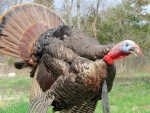- Missouri campgrounds resurgence (5/30/20)
- August a fantastic month for catfishing (8/11/18)
- Kayaking, canoeing good way to spend hot summer days (7/27/18)
- Hot weather means hot catfishing (7/7/18)
- Boat buyers have abundant options (6/16/18)
- Warm weather invites camping (6/9/18)
- Topwater fishing is a blast (6/2/18)
Area turkey hunters prepare for spring
Saturday, April 11, 2015

Ken White/Daily Mail/
A sight turkey hunters would like to see, when the season opens this month.
Nevada Daily Mail
It's turkey time!
With some cooperation from the weather, this could well be another good spring season for Missouri turkey hunters. We know there are plenty of big toms roaming around the state.

Gene Black/Daily Mail/
A pair of tom turkeys all fanned out in front of a group of hens, prior to the opening of this weekend's Youth Weekend Turkey season.
Kicking off the 2015 spring season, will be this weekend's annual Youth Hunt Weekend, followed by the regular three week season on April 20. The Youth Weekend Hunt is for young hunters who are ages 6 to 15. Their shooting hours are from 30 minutes before sunrise to sunset. Their limit is one turkey with a visible beard.
During the Youth Weekend Hunt last spring, young hunters checked 4,328 turkeys. Vernon County had 51 birds checked. The first Youth Weekend Turkey Hunt was held on April 14-15, 2001.
The regular spring season opens April 20 and runs through May 10. The shooting hours are 30 minutes before sunrise to 1 p.m. Central Daylight Time. The season limit is two turkeys with a visible beard, but only one bird may be taken during the first week. Should a hunter not get a bird during the first week, they may take two birds during the second or third week, but not on the same day.
Each gobbler has its own style and temperament which makes him a unique experience. When you are hunting a mature bird, you are matching wits with a resourceful foe. Young toms tend to gobble the most and die the earliest, and in this area of the state, reportedly, there are plenty of young birds.
With a lot of Corps of Engineers land adjoining the big impoundments, turkey hunters should find a good place to bag that gobbler this spring.
There is a lot of difference between a two-year old turkey and a wise old tom. Just as a hunter thinks he has figured out how to get that old bird, everything changes. It's hard to imagine that a bird with a peanut size brain can outsmart a veteran hunter, but he does much of the time.
After more than 50 years experience hunting Missouri turkeys, I've witnessed just about everything in the turkey woods. Tom turkeys play by their own rules and you have to be a flexible hunter because it's never the same hunt each time you go out. However, that challenge is the one reason you keep hunting every season.
Successful hunters have knowledge of turkey calls and know how to talk back to the birds. Start practicing your calls early. With the spring season soon approaching, you need to prepare. It is true, that during the first days, is the best time to get a bird.
You never know what the weather will be like as the spring season gets underway. Weather plays a big part of hunters success. If the weather is like a typical spring, you can expect toms to be fired up and ready.
At the start of the season, there is not a lot of cover so many hunters now choose to use a blind to hunt from, which should keep them well hidden. The blind can also provide protection from a spring shower.
As the season moves along, conditions will change so you need to adapt your strategy accordingly. It's a good idea to slow down your calling during the late season. If the turkeys aren't doing much calling, then use softer calls until you hit one the gobblers will respond to.
As the season moves along, there is more cover which makes it harder for both hunters and turkeys to see movement. Of course, it can also be a plus, as more cover helps a hunter be hidden. As the season nears an end, there is less competition. Real hens are nesting. Should you locate a tom looking for a hen, normally he is easier to call in.
When hunting, I usually set out two decoys, a hen and a Jake. This has worked many times. If a tom sees a Jake with a hen, he won't like the competition so he just might make a mistake, and you may get your bird.
Most successful turkey hunters avoid mistakes by watching, listening and adapting their strategies. Conditions and circumstances change during the season, so hunters have to be prepared for anything. You need to spend time in the woods so after awhile you can quickly identify what the birds want. Give them what they want and you will get your bird. Patience is the key to most successful hunts.
I know of an unidentified Springfield hunter, who spent nearly every day of last spring season, after an old tom that gave him the slip just about the time he had thought he had it all figured out.
He ended the season birdless. This year he said, "If that old tom is still out there, I'll be after him again this spring."
This scenario is the way it is with turkey hunters. The challenge awaits them again this month. Just when you think you have established a pattern, the old tom can change his routine and leave the hunter wondering what happened.
Missouri Department of Conservation turkey biologist Jason Isabelle, said, "Hunters should expect similar conditions like last year. There may be fewer two-year-old gobblers as last year, but carry over from previous years should provide great hunting."
Missouri is at the top in turkey hunting and shows no signs of slowing down. It is a sport that is very addictive. Once you have heard a gobble in the turkey woods and witness a big tom strutting in front of your decoy, you are hooked on turkey hunting for the rest of your life.
I know, because I started back in 1960 when the first modern-day turkey season opened and haven't missed a season since.

